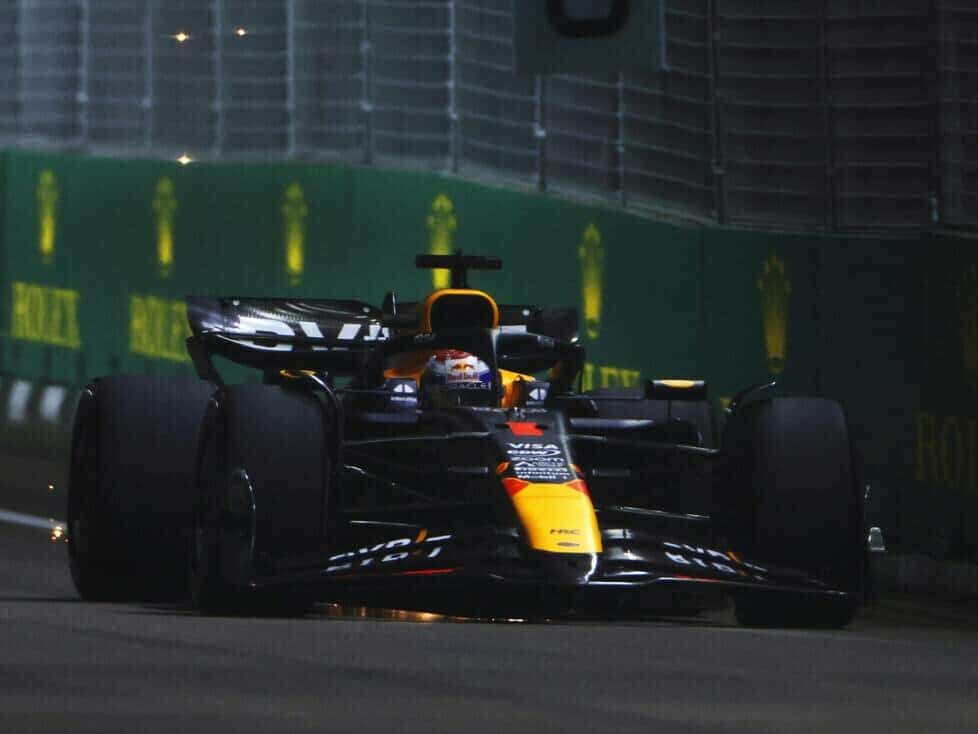Max Verstappen loses his first flying lap even though he follows all the rules – How a rule from 2021 may have cost the world champion pole position
“Why was my lap time disallowed? I lifted!” – Max Verstappen was left scratching his head in qualifying for the Singapore Grand Prix. After Carlos Sainz’s crash in the last corner, he crossed the finish line with a lift, and a split second later the red flag came out.
Verstappen did everything right. He audibly let off the throttle before crossing the finish line. Nevertheless, the lap was good enough for the best time at that point. Verstappen immediately reported over the radio: “I lupft!”
But just a few moments later, his lap time was canceled, which Verstappen couldn’t believe. Ultimately, however, everything turned out right, because Verstappen was caught out by a rule change from 2021.
Back then, it was the Turkish Grand Prix and qualifying took place in rainy conditions on a drying track. Fernando Alonso drove through a sector with double waved yellow flags on his last hot lap, but still improved by three seconds on the lap.
This race was known for its terrible sliding, and Alonso justified himself by saying that he had been extremely careful on his first fast lap. He got away without a penalty.
Alonso incident causes rule change
However, this situation led to a rule change, because Formula 1 wanted to avoid such discussions in the future. In a conversation with the then race director Michael Masi, the teams unanimously agreed to completely delete lap times driven under double-waved yellow flags.
Drivers who pass through a sector with double-waved yellow flags must reduce their speed significantly and prepare for a change of direction or to stop,“ said Masi at the time.
”For the stewards to assume that a driver has complied with these conditions, it must be clearly demonstrated that he was not trying to achieve a meaningful lap time. For practical reasons, any driver who passes a sector with two yellow flags will have their lap time disallowed.”
Drivers and teams almost unanimously welcomed the rule change at the time, because now everything was in black and white and there were no gray areas, as in the case of Alonso’s improvement on the track near Istanbul in 2021.
Fractions of a second made the difference
In the case of Verstappen, the situation was now difficult because he arrived at the scene of the accident very quickly after Sainz’s departure. There were no flag signals in sight before the last double left-hander. “I couldn’t see the car until very late,” Verstappen radioed on his cool-down lap.
But the last post before the accident site, practically right in front of Sainz’s wreck, already showed double yellow. Verstappen therefore clearly took his foot off the gas. It was a split second, but the flag was out when Verstappen passed the accident site. It was therefore already clear at this point that the lap time would have to be canceled.
Apparently, some teams and drivers had forgotten the rule change introduced three years ago. Not only was Verstappen amazed, but Helmut Marko was also surprised when he spoke to Sky: “We are a bit unhappy because Max’s first time was canceled even though he lifted. He lost a tenth and a half there.”
— Formula 1 (@F1) September 21, 2024
He believes that Verstappen could have taken pole if time had stood still: “I think that would have been enough for pole, and above all he could have risked more in the second attempt. You can risk more on a lap if you already have a relatively good time.”
The perennial issue of double yellow flags
Double yellow flags have long been an issue in motorsport because drivers often underestimate this flag signal – or can no longer afford to do so in modern motorsport, where hundredths and thousandths of a second are at stake, decelerate as the FIA’s International Sporting Code in Appendix H, paragraph 2.5.5, requires: get ready to stop.
This was demonstrated at an ADAC Formula Masters race at the Sachsenring in 2012, when two cars crashed into a track safety car under double yellow flags. Jules Bianchi’s tragic accident at Suzuka in 2014 also occurred under double yellow flags. Nevertheless, the Bianchi family sued the FIA, which led to increased vigilance afterwards.
The World Endurance Championship (WEC) has also been under scrutiny recently. Among others, former Formula 1 driver and current Toyota works driver Kamui Kobayashi was handed a drive-through penalty in Austin that cost him the race win. Toyota reacted with incomprehension to the penalty, as they had not been so strict before.
Verstappen avoided a penalty because the lifting was more than obvious. “If we had, we would have expected that time to be reinstated,” said Marko. The title defender finally qualified second behind pole-setter Lando Norris.





